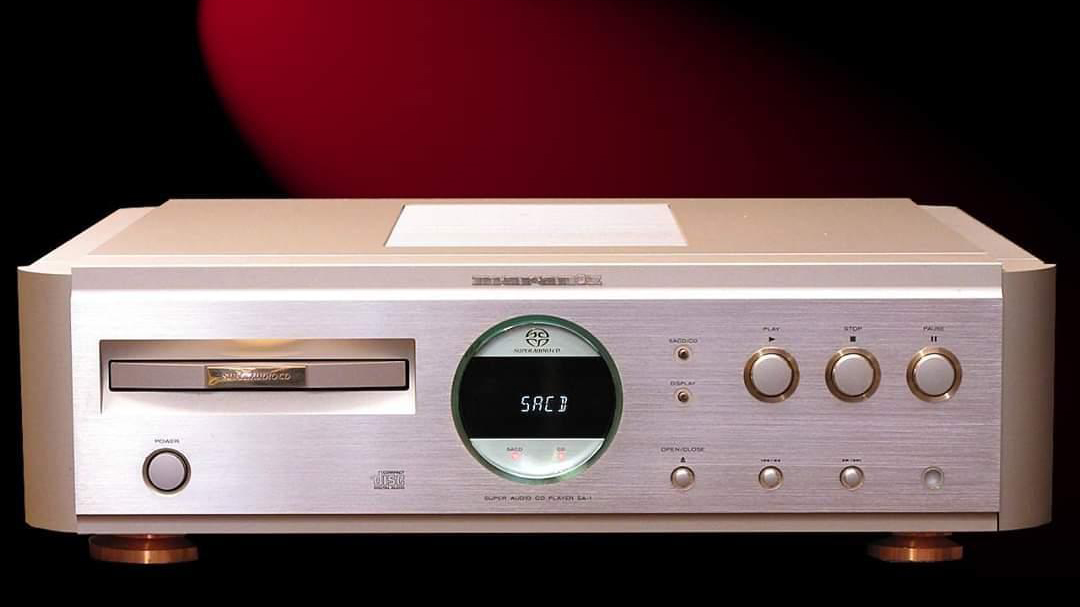
It’s a little daunting to think that 2025 is just as close to the millennium year as 1975 and that those born in 2007 are now at the drinking age (in the UK at least). Sorry if we have just ruined your day. Indeed, we can’t believe some of the hi-fi products listed below are already a quarter of a century old, with some members of the What Hi-Fi? team (we won’t name names) having witnessed – and probably written about – their launches all those years ago!
But anniversaries are there to be celebrated and woe betide us to be bitter spoilsports, so please join us in remembering and raising a glass to these momentous products on this milestone birthday year.
Quad ESL 988 electrostatic speakers & 99 pre/power amplifiers
Quad was so prolific in these years that no one can be surprised to see a pair of its electrostatics on this list, and as it so happens 2000 saw the launch of one of its most memorable and iconic models. The ESL 988 (smaller versions of the ESL 989 pictured) were designed as similar but improved successors to the 1988 ESL-63 when the International Audio Group (IAG) acquired Quad in 1998, with more advanced components, a new transformer and a more rigid construction.
The launches of Quad’s 99 amplifiers in their pre, mono and stereo power implementations, meanwhile, straddled 1999 and 2000 and, a few years after their arrival, we had this to say about the pre/power combo: “This Quad preamp is still one of the best at this price. Its even-handed nature and high levels of insight make it a star, and when partnered with one of Quad's power amps it has a rich and weighty bass performance that goes very deep without losing grip.”
Ruark Excalibur speakers
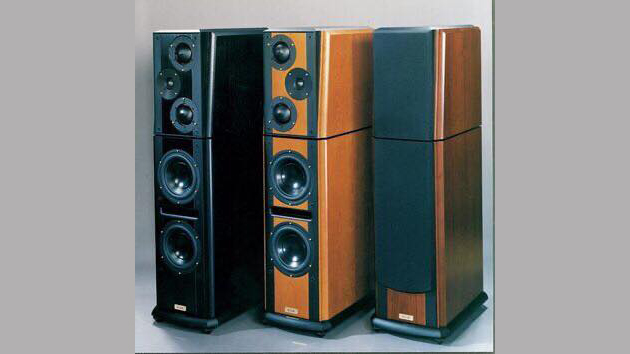
While Ruark Audio is today the creator of arguably the finest looking and sounding radios and tabletop systems around, its foundation and formative years revolved around manufacturing passive loudspeakers. After a decade of producing high-quality stereo speakers (we have fond memories of the Talisman and Crusader floorstanders of the early ’90s in particular), and having moved from its modest Rayleigh factory to a larger one in Southend-on-Sea (where the company still resides today), Ruark Audio released the Excalibur in 2000. This was just after the founder, Brian O’Rourke, retired and his son Alan took over the role of managing director, which he still holds today.
Of the Excalibur speakers, Ruark says: “It had always been a desire of Alan’s to design and build a speaker without compromise that was capable of real-life dynamics. A speaker that was able to create the full scale of an orchestra or band without compression or distortion. At over £8,000 per pair, the Excalibur became regarded by serious audiophiles as one of the most awesome speakers available, and during production, nearly 300 pairs were sold worldwide.” It would be one of the final Ruark loudspeakers before the brand changed direction to develop DAB radios.
Marantz SA-1 SACD player
More than one high-end Marantz disc player has become the stuff of hi-fi legend, including the CD-94 of the late ’80s, the CD-15 and CD-52 MkII SE of the early/mid-’90s, and the CD-7 that soon followed it (and would later secure a spot in our best CD players of all time list alongside the aforementioned CD-52). At the turn of the millennium, when both SACD and DVD – two disc formats whose technical abilities went far beyond the humble Compact Disc – were emerging, Marantz remained utterly committed to the CD player. But it didn’t ignore those newfangled concepts. The SA-1 SACD player (pictured top) marked Marantz’s intention to join Sony in producing SACD machines, and it was a triumph.
Mission 780 & 782 speakers
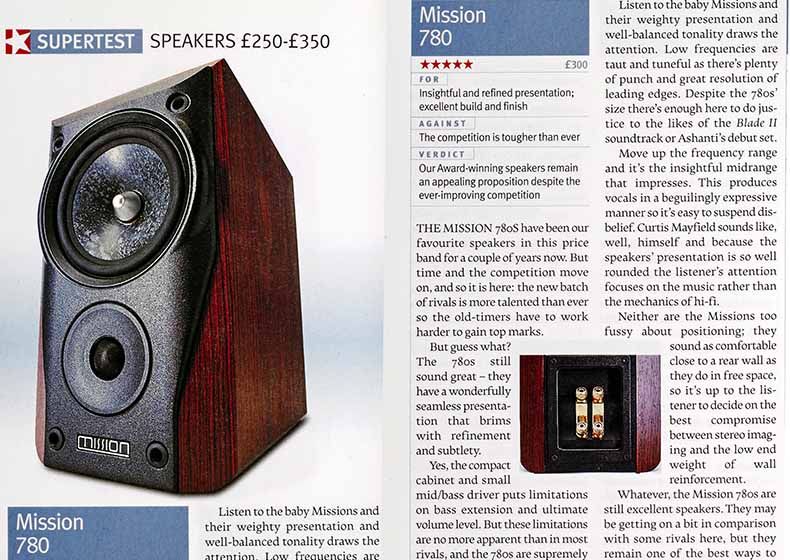
Mission released two models in its 78 Series that would go on to cement themselves in the hi-fi history books and become one of the many designer highlights of Peter Comeau, Heybrook co-founder and (now) Director of Acoustic Design at IAG. These were the 782 three-way floorstanders and the 780 two-way standmounts.
The latter were the smallest in the series and became What Hi-Fi?’s first Product of the Year speaker of the new millennium (it also bagged a second accolade the following year), attributing its impressively big sound, high and mid transparency and taut, powerful bass to some clever technical features, including a tweeter isolation system, a ceramic mid-bass driver and a cabinet construction that aided structural rigidity. The 780 and 782 could handle any genre of music you threw at them and were stellar examples of craftsmanship, too.
Bose QuietComfort headphones

The QC1, sold between 2000 and 2004 before their QC2 successor took over, were the debut model in what has become the most iconic noise-cancelling headphone range of all time. Boy did Bose hit the jackpot here. The first QuietComforts were the company’s first consumer pair and borrowed the sound-blocking technology from its earlier commercially available active noise-reduction headphones, which were designed exclusively to help pilots land planes, powered either by NiCad batteries or the aircraft's cockpit.
25 years and roughly 10 consistently impressive QuietComfort over-ear pairs later, the range still impresses, headed up by the five-star QuietComfort Ultra flagships. No wonder it features in our list of the best headphones of the 21st century.
Naim NAP 500 power amplifier
While it is Naim’s 32 pre-amp, accompanying power supply and the now legendary 250 stereo power amplifier that feature in our favourite Naim products of all time, the NAP 500 was a hugely important product in the British company’s history. While every amplifier before it in Naim’s 27 years was based on the circuit layout and founding principles of founder Julian Vereker, the NAP 500 power amplifier ushered in a new approach, elements of which are still present in Naim amps today.
Naim wanted a design significantly more powerful than existing ones, and thus the NAP 500 was capable of delivering 200 watts per channel into 4 ohms (the 250 delivered 125 watts into that same load). Interestingly, its most powerful amp yet was designed to operate in bridge mode, conceptually working as two mono amps within one chassis, and facilitated by the move to a new and powerful output transistor device (Naim knew its existing one would soon be obsolete) that came from Semelab. NAP 500 development also saw the toroidal transformers and power supply electronics housed separately from the amplifier (linked by a conductor cable) in the name of sound quality.
And while the styling of Naim products evolved from their original 'chrome bumpers' to the more modern 'olive' look, the NAP 500 adopted the all-black and anodised alloy panel styling still seen today.
Tivoli Model One radio
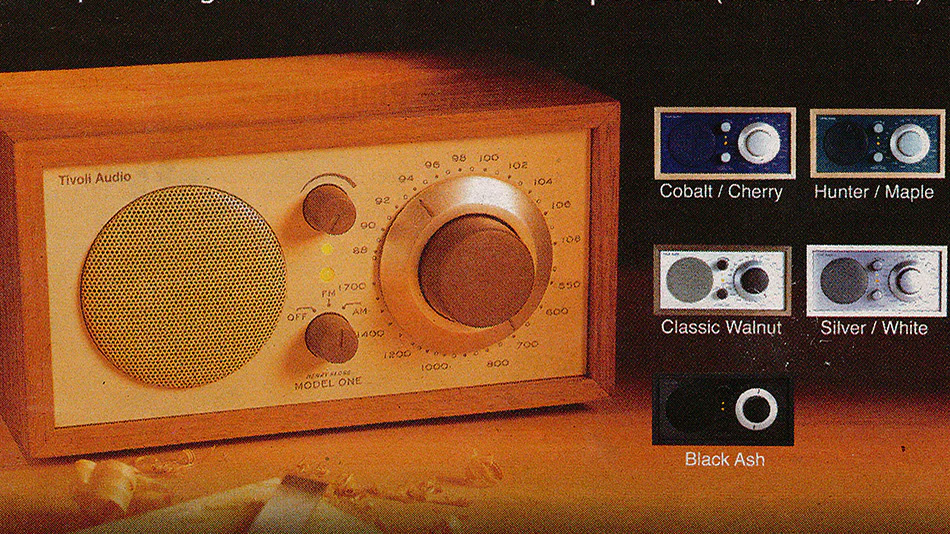
Tivoli Audio got off to a running start when it launched itself into the consumer audio market with the Model One, a tabletop radio engineered by Henry Kloss, who had designed speakers for KLH decades prior. The radio’s instant success with both the audio and lifestyle media soon spawned several more chic models, including the fittingly named Model Two and Model Three, all with those striking fascia-dominating analogue dials and handsome wooden chassis, and the Model One still plays a big role in the company’s lineup and design ethos. In 2020 it produced a limited-edition run of Model One BTs in a high-gloss lacquer-coated walnut finish, while the latest Model One Digital Generation 2 took home a What Hi-Fi? Award in 2022.
The Model One also inspired a new direction from Ruark Audio, one of the tabletop radio system’s leading lights today. “Tivoli was quite unique when it hit the market”, Ruark founder Alan O’Rourke told What Hi-Fi? last year. “We hit the floor running and got loads of interest not only from the usual hi-fi media but also the lifestyle media. And John Lewis loved it; it was perfect for their customer. Doing the Model One for a few years opened our eyes to the market.”
NAD C370 integrated amplifier
Another Product of the Year winner in the 2000 What Hi-Fi? Awards, and our favourite amp for two whole years, the C370 was hardly a looker, even at that time when functional over fancy aesthetics were typical. But what it lacked in beauty it made up for in brawn and brains. We called this NAD a "dynamite amp that has power and poise in equal measure" and it fended off competition from the likes of Marantz, Rega, Cyrus and Arcam, which was certainly no mean feat.
NAD had secured a reputation for delivering high-performance, high-value amplification, and the $700 C370 didn't hurt that one bit. You got 120 watts per channel (8 ohms), no shortage of inputs and the ability to use it as an integrated or preamp, and the benchmark sound quality described above.
Exposure 2010 CD player
Like Marantz, Exposure was best known for its amplifiers, but the company had shown promise with the first iteration of the 2010 CD player, before, according to our list of the best British CD players, the model reached its zenith in 2005, where its performance reached new heights. Still, that original was notable, using a Sony mechanism and the latest developments in 24-bit/96kHz DAC technology. What we admired about the original version was how it manifested an "exhilarating sound" and "exciting dynamics".
The competitively priced electronics series also comprised an integrated amplifier, a power amp and an AM/FM tuner. In What Hi-Fi?’s October 2000 issue, we called out Exposure’s reputation for “building big, bold sounding amps boasting a rhythmic ability that leaves most rivals for dead” and said the 2010 integrated “goes as loud as you could want, delivering a punchy, thrill-a-minute performance”. It was a decent start to the 2010 range that paved the way for years of hits.
Bowers & Wilkins CDM NT1 speakers
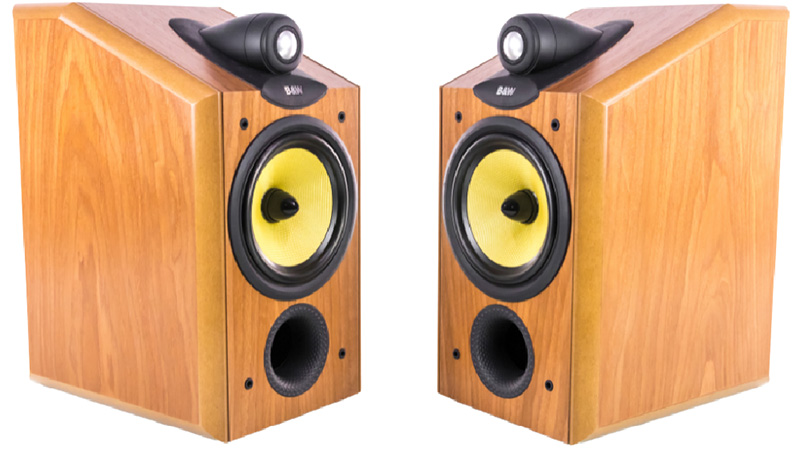
Two years after Bowers & Wilkins introduced its Nautilus 805 flagship standmounts (an evolution of the preceding Matrix 805), it launched the more affordable CDM NT range, of which the NT1 was the smallest bookshelf model. Despite their relatively modest cost ($1200), they (like the previous CDM1 SE) featured many of the engineering principles of Nautilus – the 25mm alloy dome tweeter-on-top configuration with a Nautilus tube that eliminates resonances behind the dome diaphragm; a 16.5cm woven Kevlar mid/bass cone; and the dimpled Flowport reflex ports that improve airflow and reduce chuffing noise. The smart real-wood-veneered cabinets also had contoured edges to reduce sound diffraction.
This trickling down of technology (or “waterfall” design policy, as B&W called it) produced a premium – but not Nautilus-premium – hit, ideal for smaller rooms. We called them one of the best performers at their level at that time.
Rega P3 2000 turntable & Brio 2000 amp
24 years after Rega launched its P3 turntable in 1976, here came the second generation, the P3 2000. (Rega released a double-digit haul of products in 2000 and most of them carried the ‘2000’ name.) Incidentally, there would be only seven years between that second and the third P3 model, the P3-24, which added some serious upgrades, including a new plinth, arm and motor, and was our pick of the earlier generations in our best Rega products of all time list.
While the latest model of the mid-market marvel has been completely redesigned over the original, this second-gen player carried over many of the original elements, including a belt-driven design, 12mm glass platter and Rega’s aluminium alloy, one-piece RB300 tonearm (which was swapped into the original in the ’80s) naturally following Rega’s lightweight and rigid engineering approach to controlling resonances.
The Brio 2000, meanwhile, was the third iteration of the company’s most affordable amplifier (until the budget io model came along in 2020 anyway). Having launched the higher-end Elex and Elicit amps in 1990, Rega introduced the original Brio a year later and it received immediate success thanks to its musically engaging sound. The model peaked with 2011’s Brio-R, while the 2018-released Brio has just been discontinued to make way for an all-new digital-friendly model.
Roksan Kandy KA-1 amplifier
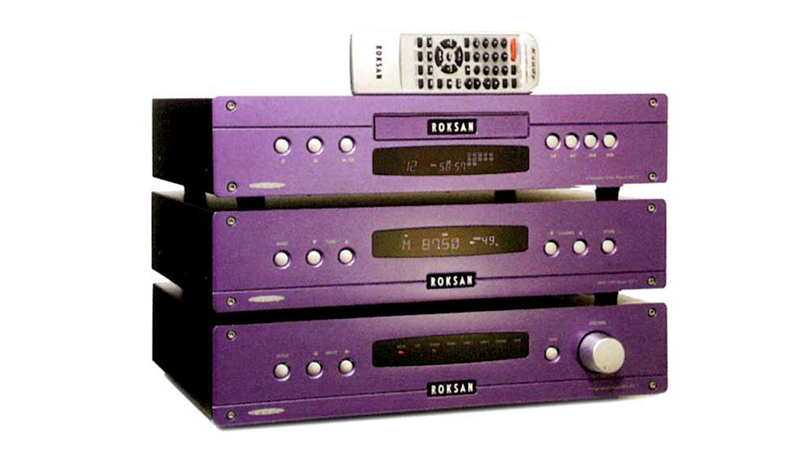
Two years after the arrival of its Capsian Series, which saw the brand gain reputation among audiophiles, Roksan introduced the more affordable Kandy Series. It comprised the KC-1 CD player and KT-1 tuner, but the jewel in the range’s crown was the amplifier, which scooped three What Hi-Fi? Awards for its class-leading performance (though the later upgraded version, the Kandy L.III, would go on to claim the even more esteemed Product of the Year gong while the later-still K2 would become our favourite Kandy yet).
The KA-1 was a powerhouse, capable of delivering 110 and 170 watts into 8 and 4 ohms respectively, and represented excellent value – particularly as it complemented its sonic talents with a useful feature set that included a switchable line-level/moving-magnet phono input, a headphone jack and a 20dB mute control. All that made it easy to forgive its quirky LED mode indicator, which turned green when the amp was powered off and red when it was on.
KEF KHT2005 satellite surround package
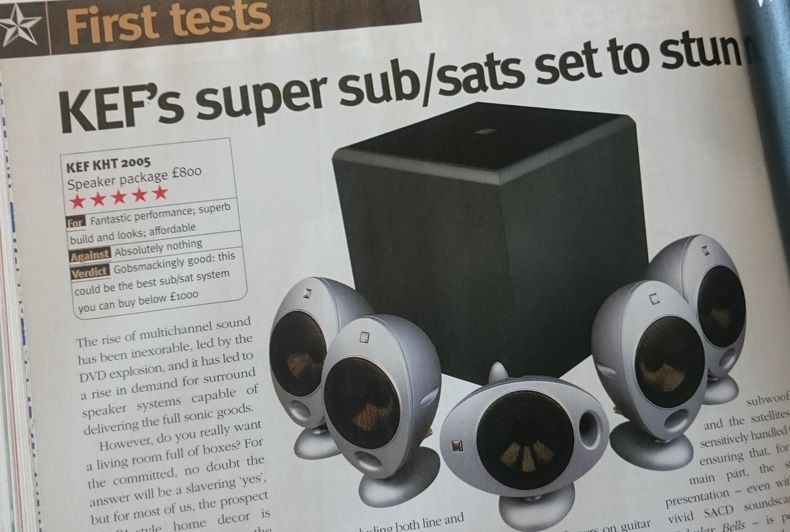
The ‘egg’ shape has played quite a role in KEF speaker design over the years (even relatively new hi-fi hobbyists may remember KEF’s 2015-released Egg wireless speaker system), and it all started with this satellite surround-sound package, which spawned various generations and incarnations in the 21st century that between them have won almost as many What Hi-Fi? Awards. Not only that but it’s our single Hall of Fame entry of that year, too.
In our review of the “sub/sat” package, we said it was “effortlessly stylish, very compact, sounds excellent with both music and movies, and costs a more-than-reasonable £800. It's superb; we can't really put it more clearly than that." Almost a decade later, we were still calling out the aptitude of this then-“long-established favourite” model for both music and movie reproduction. “It's going to take something very special indeed to knock this system off its perch,” we said of the KHT2005.3. Other manufacturers attempted to emulate KEF’s success in this sensible form but to relatively little avail.
Wharfedale DVD-750 DVD player
As our magazine editor, Jonathan Evans, penned not long ago, having just dusted off and flicked back through the pages of What Hi-Fi?’s July 2000 issue, we were amazed then at how we could find such quality home cinema for remarkably (relatively) low prices. DVD was home cinema heaven, and few machines were as bright a harbinger of the AV reverie that was to come as Wharfedale’s groundbreaking DVD-750 player.
It was a budget player at the time, just £180 and stocked in the UK’s Tesco superstore, and demand was so high that our reviews team had to purchase one to review. While, to quote our review from back then, its “cluttered handset, primitive on-screen menus and noisy disc door” highlighted its modest status, its performance was nothing short of impressive. “A fully-loaded deck that makes a terrific value movie source and even manages to be a good budget CD player,” we concluded.
MORE:
The best 39 hi-fi speakers of What Hi-Fi?'s lifetime







